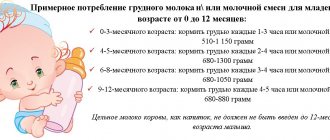Principles of formation of color perception functions in a child
Before starting to study practical tips and techniques, parents need to familiarize themselves with some features of the development of visual functions in children.
This will help you use the acquired knowledge in the right way. So, a child’s ability to focus on any object appears at the age of 2-3 months. Usually the first thing a baby learns to distinguish is the mother's breast. This is due to the fact that at this age the color perception of the child’s eye is adjusted in such a way that the child can clearly see the mother’s nipple. The colors that he can distinguish between 2 and 6 months are in the wavelength range of a wide spectrum: red, pink, brown. The ability to distinguish short wavelength colors, blue and green, appears closer to the seventh month of life, and full color perception is formed in a child by the age of eight.
Tips and tricks from experienced moms and dads
Now that we know the basic principles of forming children's perception of the color palette, we can begin to study recommendations and advice from more experienced parents.
- Teach from an early age. Don't underestimate children's learning abilities. Even if a child cannot speak yet, this does not mean that he is not able to understand or remember something. If you regularly communicate with your baby and tell him what color, for example, his favorite rattle is, this will definitely stick in his head. And in the future, when he can consciously construct different words, it will be easier for you to explain the difference between one color or another;
- Link new knowledge to emotions. Human memory is designed in such a way that we best remember pictures, vivid images and emotions. It’s not for nothing that they say: a person will remember not what you did for him, but what you made him feel. Use this technique in teaching children. For example, start learning colors with your favorite fruit;
- Practical use. New knowledge should be used immediately by the child. If you have learned something new with your baby, try to make sure that he begins to apply it in life. You have learned the color red, so when you are going to go out, ask him to bring you his red jacket. The more often you encourage your child to apply what they have recently learned, the better they will remember it all;
- Encourage your child to share what he has learned with others. After you've learned a new number or color, have your child call grandparent and tell him about it. This principle works very effectively in conjunction with practical application. For example, dad came home from work in the evening and went to wash his hands before eating - let the baby give him a yellow towel;
- Speak in different phrases. Always say color in different contexts so that the child does not perceive it as one word: this is a red ball, the ball is red, this is a ball, it is red, etc.;
- Avoid diminutive words (little blue, red);
- Hold off on the shades - it’s better to leave all light green, pink and blue shades for later;
- Do not start learning a new color until the child has mastered the previous one! (We start with red, and then get acquainted with yellow, green, blue).
Although this article is about how to teach your child to distinguish colors, the principles outlined above apply to more than just that. Using them, you can learn both letters and numbers. Below we will look at several effective techniques that will help parents teach their children about the color palette.
Learning colors during everyday games and walks
Generally speaking, I am convinced that in order to teach a child to distinguish primary colors, there is no great need for special classes; it is enough just to regularly name the colors during your regular games. When you draw, be sure to pronounce the colors of the pencils; when building with cubes, construction sets or mosaics, don’t forget to remember the shades of the details. The same applies to dressing, walking, sculpting, applique and your other favorite activities - in conversation, constantly name the colors of the objects and playing materials around you.
Just remember that “learning colors” does not mean that you have to constantly examine the child “Tell me what color it is”, “Show me where red is”, etc. A child, like any other person, does not like being tested on his knowledge, so at first just name the colors and answer your own questions: “Where is the yellow cube? Here he is!" “Let’s draw the grass with a green pencil.”
When should you start learning colors?
By the first 2-3 months of life, a child begins to distinguish the color red. This is explained by the fact that the cones (special elements of the retina), which are sensitive specifically to the long-wavelength part of the light spectrum, begin to work first.
At 1 year old, a baby can distinguish 3 simple colors - red, yellow, blue and 1 complex color - green. However, it is still difficult to check what exactly a one-year-old toddler sees. In each specific case, everything depends on the development of speech and thinking.
It is worth actively starting to learn colors with a 1-year-old baby, but children can remember and distinguish only from 2 to 3 years old, when an active cognitive interest appears.
Diseases that make it impossible to teach colors to a child
It is worth remembering that if a 4-year-old child does not distinguish colors, cannot remember what seems elementary, wants to learn, but cannot recognize one, two or even three colors, do not scold him, but consult an ophthalmologist.
There is a hereditary disease, color blindness, in which color recognition is impaired, so such a developmental activity as teaching a child to distinguish colors will have to be abandoned for a while.
Using Rabkin's tables and then a certain light filter, the doctor can establish a violation of sensitivity to 1, 2 or even all 3 primary colors. It is impossible to cure the anomaly at this stage of medical development. However, glasses with specially made lenses that act as a light filter were offered for children and adults.
Glasses are made specifically, depending on the existing sensitivity disorder. The filter can be red, blue, green, or combining both 2 and 3 shades.
Problems in teaching colors
Some parents believe that their children know colors better than other children. This is because children may have difficulty separating color from an object. If you use the same objects to teach and describe colors over and over again, your child is more likely to associate the name of the color with the object. They don't understand the difference between a color and a noun. For example, when you name an object a red ball, your child perceives all the names of the ball as a red ball, rather than separating the name of the color from the name of the object. Developing the ability to distinguish color from an object takes time. Many parents use shapes and colors together to teach their children both. This is a great idea, but your child probably doesn't know the difference between green and triangle. The concept of color becomes too abstract to comprehend.
Learning to distinguish between red and blue colors
We learn to understand that color is not an object, but a sign of an object. We start with two colors and play until we begin to distinguish different colors. An adult reads the name of the color to the kids.
Learn the colors red and green
Now we are learning two colors: red and green. Two different colors, you need to understand that these are signs of objects.
Another problem that parents face is when children know the names of colors without being able to correctly match those names to the color. Keeping in mind that children develop at different rates, many children develop language abilities before they learn color. Don't worry if your baby knows and says the names of colors, but doesn't accurately identify those colors with an object. If your child calls his red fire truck yellow, that's okay. Consider this a good sign that your child already knows these names. Your task is to help your child correctly associate names with colors.
Stages of teaching a child colors
In the process of studying color shades, there are several stages. Before you start learning the names of colors, you should make sure that the baby can distinguish between them. Some children are unable to distinguish colors well until they are three or even four years old. But starting from 1 year 5 months, color discrimination tasks can be offered.
Before the age of two, simple color sorting exercises can be introduced. At first, it should be contrasting two or three colors, for example, black and white. The items must be the same. That is, the child must separate, for example, multi-colored circles. You can separate the white beans from the red ones. By the way, this exercise perfectly develops fine motor skills of the hands.
As soon as the baby has mastered such sorting well, you can begin more complex exercises. One such exercise is sorting different objects by color using a spoon or tweezers. This activity can be offered to a child closer to three years old, when he already has good control over the work of his hands and fingers. As soon as parents are sure that the baby distinguishes the colors of the main spectrum, they can begin to study their names.
For this purpose, Montessori pedagogy uses the so-called three-stage lesson. Three objects of different colors, but identical in shape and size, must be laid out in front of the little student. Montessori education uses colored cards or spools of thread.
1st stage. The adult shows the cards to the child and says: “Here is blue, here is red, here is yellow.”
2nd stage. An adult asks a child: “Where is the blue one?” Show me yellow! Where is the red one?
3rd stage. An adult points to an object and asks: “What color is this?”
If the child answers incorrectly, then you should not correct him, you just need to work through the previous step a few more times.
Step by step work
You need to start with the basic options, for example yellow and red, they are easier for the child. The following table shows the stages of the learning process by age.
| Baby's age, years | Available forms |
| 1-1,5 | Mom can name not only the object itself, but also its color. You can hang a multi-colored bright rattle over the crib and repeat the color of its elements every day, touching them one after another. Despite its apparent uselessness, this activity helps the child gradually memorize his mother’s words so that he can then begin to use them. |
| 1,5-2 | The repetition of colors continues and it is important to use active listening. So, the mother can ask the baby to bring her a red ball. Drawing with finger paints or crayons will be useful; the adult will name what shade the child uses for creativity. |
| 2-3 | Spectrum training enters the active stage. You can use Dienesh blocks, invite your little one to classify objects by color, and find the odd one out. |
| 3-4 | We continue to get acquainted with colors and their shades in a playful way. |
Each activity should turn into a little holiday for the baby, so you can safely use games and turn on his favorite music. The main thing is that the child should not be overtired; it is permissible to study for only two minutes, but several times a day - this will be much more productive than boring memorization and repeated repetition.
Five techniques
There are a huge number of different ways, using which you can teach a child at the age of three to distinguish between six colors (red, blue, yellow, green, white and black), and more. But if you delve into their essence, then almost all of them come down to five simple pedagogical techniques. We will talk about them below.
- Informal learning. The essence of this method is to teach the child in the process of everyday communication. For example, on the way to a park or kindergarten, a child is asked to count together the green cars that will pass by him. Naturally, before this, the parent must show the baby what the color green looks like. The effectiveness of this method lies in the fact that the child is given complete freedom of action, no one limits him in anything. He can do whatever he wants along the way, as long as he doesn’t forget to count the green cars. By the way, the number of cars counted doesn’t matter at all either: ten passed, but only two were counted - well done!
- Creativity. At this stage, you will need to make sure that the child has paints, pencils, markers or plasticine. Ask your little one to choose the color he likes best and tell him what color it is. Let it be blue. Invite your child to draw something together, for example, a blue circle. Say that this is a blue balloon that does not have a string, and if you do not finish drawing it, the balloon will fly into the sky. Ask the little one what color the lace should be if the ball is blue. The same can be done with plasticine. Read also: What does a child’s drawing say?
- Use of toys. Specialized stores for children sell a huge number of educational toys that help them remember numbers, letters and colors. The most productive of them for memorizing colors are pyramids of rings, puzzles and construction sets.
- Interactive books. Their effectiveness lies in large colorful pictures that attract the child’s attention. As a rule, such manuals offer all kinds of tasks, by completing which the child simultaneously participates in an exciting game, develops fine motor skills of the fingers and learns the color palette. For example, in the book by Anna Goncharova, the baby is asked to learn colors in poetic form, and in the manual by Olesya Zhukova, the toddler can draw directly in the book with his fingers.
- Story games. Come up with simple games in which the child can use his senses. For example, take two multi-colored balls and make houses of the same colors for them. Houses can be painted boxes or sand buckets. Place the balls in the corresponding houses. After everything, take them out of there and tell the baby that they went for a walk. Suddenly a wolf appears from somewhere and wants to eat the balls. They urgently need to be rescued! Tell your child that each ball must be quickly returned to its house, otherwise the wolf will eat them. The essence of such a game is to evoke emotions, empathy and sympathy in the baby. This will activate additional parts of the brain and help you remember the right colors even better.
Using these techniques in their various variations will help achieve good results in the shortest possible time, but remember, each child is individual. All babies develop differently, and in no case can you compare them with each other. If it seems to you that your baby is not learning as quickly as other children, there is no need to panic or be upset.
Learning by playing
It is known that children learn faster through play. Studying flowers is no exception. Therefore, if you want to teach your child to distinguish colors, we recommend using games.
- Find the color. At the initial stage of study, while the child cannot yet name colors, you can ask him to find objects of a certain color according to the pattern you showed. It is important to first choose items of the same shade. To do this, you can use cubes, mosaic parts or construction sets;
- Arrange by color. To do this, you can use buttons or bright beads. Invite your child to put, for example, large blue buttons in one box, and small blue ones in another. If there are buttons of different shades of the same color, then you can ask the baby to put them in a row from the lightest to the darkest;
- Confusion. For the game we need multi-colored pens. Adults remove the caps from them and offer to help the child choose the right caps for certain pens. During the game, you can deliberately choose the wrong cap - the baby will definitely correct you;
- Cap. Make caps from multi-colored cardboard and place them in front of the child. An adult recites a poem: “I’m going, I’m going to visit on a horse in a yellow hat!” — in this case, the child must choose a cap of the desired color and put it on his head;
- Find the extra one. Among the four balls, 3 should be one color and 1 another. The child needs to find a ball that is different in color from the others;
- Funny beads. Make circles of different colors from colored paper or cardboard. Prepare a bead template and invite your child to arrange his beads according to the pattern you suggested;
- Arrange the balls correctly. An adult pours colorful balls onto the floor and places several boxes. A ball of a certain color is placed in each box. The child needs to collect the balls and put them in the appropriate boxes.
To ensure successful learning, always comment on your actions and end the game as soon as the child shows the first signs of fatigue or loss of interest. And don’t forget to praise your child for every achievement, and then teaching your child to distinguish colors will not be difficult for you.
Toys to help your child learn to distinguish colors
"Hooray. Rainbow". This game is for children 2-3 years old. The child needs to correctly, selecting them by color, arrange the pictures according to the rainbow.
The game “Halves of a Flower” is also intended for children 2-3 years old. It develops a holistic perception of color. The child needs to match the halves of the flowers by color. You can download the pictures on a color printer and cut them.
Or, for example, the game for kids “Colors”. It is a didactic mosaic for kids. Consists of eight large cardboard cards, cut into 2 elements using PUZZLE technology. Some halves of the cards depict objects familiar to the kids, and the other halves show pencils that match them in color.
And also a good educational game “Magic Color” Included: a playing field (33 x 48 cm in a spread) - a castle on the river bank, a small book with text and tasks “Journey to Gnome or the Colored Kingdom” and a set of reusable stickers - gnomes, a mole , all the colors of the rainbow and more. All the colors of the rainbow on your magical palette. Children go to a fairyland where colorful gnomes live. While playing with magic Velcro, they will learn what the colors of the rainbow are, primary colors, cold and warm, contrasting and close. Good wizards will tell you how to create new color combinations, which will help your child when he picks up paints and brushes.
If something goes wrong
Some parents and teachers, seeing that the child stubbornly continues to confuse colors, may draw erroneous conclusions regarding the child’s mental abilities. If you are faced with a similar situation, do not rush. Some children may have a banal delay in early development, but over time everything will work out and the child will catch up with his peers.
Another reason why children may not distinguish colors is impaired photosensitivity. This is when a child’s perception of certain colors and shades is impaired. However, it often happens that such disorders are not diagnosed at all, since the baby has learned to distinguish colors by brightness and contrast.
It also happens that a child even at four years old not only confuses colors, but almost does not distinguish between them. This may be due to a variety of reasons, among which three main ones are worth highlighting:
- The study of colors began too late; the baby simply has not yet fully mastered these names and cannot easily apply the knowledge received from his parents in practice.
- The peculiar pace of assimilation of information, which may be associated with the child’s temperament - it is quite possible that he has already remembered everything perfectly, just so far he does not risk making certain statements about the colors of objects.
- Problems with vision, and in this case it is best to go to the doctor once again and hear his recommendations, rather than think and guess what will happen next.
In general, you should approach studying colors with your child carefully and responsibly, but at the same time calmly. A playful attitude is very important; with it, a child will learn this rather complex topic much easier and more interesting.
Everyone understands that by the age of three a child should be able to distinguish colors and be able to name them. Of course, a child cannot immediately remember all the variety of colors, but he must distinguish and know basic colors, such as red, blue, yellow, green, white and black.
Determining color using toys
In addition to homemade aids, you can offer your child ready-made games and toys designed for learning colors.
These include the previously mentioned cubes and construction sets, lacing with colored beads, and board games. For example, colored lotto. There are game options in which the child must match each picture with a corresponding card with a color palette. There are simpler lotto games, in which you just need to sort the cards according to the color of the objects depicted on them.
The child feeds the bear and remembers the colors
When buying lotto or books to study colors, you should pay attention to the quality of printing, as in some publications the colors may be distorted.
There are also educational cubes and houses with colored doors, for which you need to select keys of the desired color.
Many games can be created with sets of plastic figures of “vegetables”, “fruits”, “animals”, etc.
How to properly teach colors to your child in Russian in a playful way: techniques
Surprisingly, some bright babies can distinguish several colors before they are one year old. However, this is due not only to the child’s good innate characteristics, but also to the perseverance of parents who pay sufficient attention to their children. It is known that the child’s cognitive activity is also influenced by the development of his motor skills (fine), so other activities should not be ignored.
IMPORTANT: In order for the child to quickly remember the names of colors, all words should be introduced gradually. But before starting such lessons, he should definitely be introduced to paints, plasticine, and pencils.
Effective and playful techniques:
- We name everything correctly and clearly. It's not really a game, it's a habit. In any activity, you should be sure to name colors as an object. For example: do you want me to pour you tea into a BLUE cup or let’s put on this RED blouse.
- Comparison. When naming one of the colors, you should definitely compare it with what the baby already knows so well. For example, the car is blue like the sky, and the pancake is yellow like the sun.
- Asking “what do you like.” By attaching his feelings to the names of colors (like or dislike the color), the child remembers them easier and faster. For example: I like pink and don't like black.
- A change of scenery. Sometimes the educational process becomes boring for a child only because it happens the same way and always in the same room. A change of environment will help your child show interest in the lessons. Moreover, you can study not only by imposing knowledge, but also “by the way.” For example, if you are in a store, take the time to stop by the fruit and vegetable department to name all their colors.
- Entertainment. If it is difficult for a child to perceive the simple speech of his parents, you can replace it with songs and sonorous rhymes, which are much easier and more pleasant to perceive and are easily remembered for a long time.
Game forms of teaching children colors
How to teach a child to distinguish colors? Games
1. Sorting by color
In “sorting” games, the child is required to divide objects into groups, focusing on their color, and you are also required to constantly voice the names of colors so that they are deposited in the baby’s head. What can you sort? Here are some game options:
- You can make a color sorter from any unnecessary box; just cover the box with colored paper and make a few slits. You can push mosaic pieces, multi-colored paper clips, buttons, etc. into the slots. Our sorter is made from a tea box and mosaic pieces. Sometimes there are ready-made options.
- We sort the beads into bowls. Imagine with your child that the beads are candies that you need to treat your toy friends with. At the same time, the bear loves only green candies, and the lion cub only loves red ones, so you have to try very hard not to offend anyone
- We lay out toys and other small household items on the floor and invite the child to sort them into boxes of the appropriate color. Instead of boxes, you can prepare a large sheet of paper with different colored sections. Our game was much more dynamic when we distributed colored sections between Taisiya and her favorite toy. For example, Tasya took away all the red objects, and the doll Masha took away all the yellow ones.
- We find a mother hen for each testicle, focusing on color.
Place all the eggs in a cut-off plastic cup attached to the chicken.
You can come up with a huge number of color sorting options; it’s impossible to list them all here. You can arrange colorful butterflies into flowers, fruits and vegetables into baskets, and place colorful little animals into houses... By the way, in the Moneybox of games from readers there are also good options for color sorting.
2. Games from the “Match a Pair” series
Games from the “Match a Pair” category are also well suited for learning colors. You can select lids for houses, caps for gnomes or clowns, housing for colorful people, etc.
You can try this version of the game: lay out the incorrect version in front of your child in advance and ask him to correct the mistakes.
3. Color lotto
Games based on the lotto principle become interesting to children at about a little over a year old. Of course, for now the kids don’t play by adult rules, but simply match cards to the playing field with pictures.
In color lotto, the pictures on each playing field have only one color. (An example of a colored lotto can be DOWNLOADED HERE ). Therefore, to collect such a lotto, the child needs to select cards of a given color from the rest and place them correctly on the field.
In a more complicated version, you can simultaneously use 2-3 playing fields, and also learn to compare color and black and white images, as in the game “Dwarfs and Houses” (Ozon, My-shop, Read) from the “School of the Seven Dwarfs”.
4. Colorful days
This method of introducing color is very popular now. It lies in the fact that within one day (and some even stretch out this pleasure for a whole week), the child very often “comes across” the same color, regularly hears its name and, accordingly, quickly remembers it. So, on red day, you and your baby can dress in red clothes, find all the red toys and even eat red fruits and vegetables. Of course, all this time you will remind your child what color is on your way. Here is a sample list of what you can do on a “colored” day:
- Together with the baby, we look at pre-selected toys of the color being studied;
- We put on clothes in appropriate colors;
- We walk around the apartment looking for toys and other objects of the color being studied;
- While walking, we look for cars of the color we need;
- Playing with a color sensory box;
- We look at a book or cards with pictures of the color we need (cards);
- We sculpt from plasticine using only the color of that day. A similar approach can be used in drawing and appliqué;
- We play lotto of a given color (see above);
- We include in the menu products of the studied color (For example, for a red day the following are suitable: berries, tomatoes, red apples, pomegranates; for a green day : grapes, green olives, lettuce, peas, green apples, green beans, kiwi, avocado; for a yellow day : banana, corn, yellow apples, lemon, butter, cheese, pineapple; for white : rice, cottage cheese, semolina, milk; for orange : carrots, apricot, pumpkin, orange)
5. Doman cards “Colors”
To be honest, I believe that studying colors using Doman cards is the simplest and at the same time the most effective method, especially if we are not talking about too “traditional” tones. Doman classes require a minimum of effort and time, and the colors are almost guaranteed to be remembered, especially if the child has already had experience interacting with cards before. Just remember, in order for the learned colors not to fly out of the child’s head after a month, their names must be reinforced through other games (sorting by color, playing lotto, etc.).
What is also important: learn only those shades that you yourself distinguish and whose names you are really ready to use in your games and conversations. Don’t get carried away with sets like “100 flowers” from “Umnitsa”. What's the point of learning, for example, the shade purple, if when you encounter it in life, you yourself will most likely call it purple. This will only confuse the child.
My daughter and I started learning colors using cards at 1 year 4 months (by that time Tasya already knew and showed the four primary colors). Over the course of a few days, we memorized another 14 colors from the cards (a total of 18 in our arsenal) and began to mention their names in our games. For those who are skeptical about Doman’s method, I can assure that Taisiya to this day has not forgotten any of the colors she studied then!
Read more about the Doman method and the principles of training here. “Colored” cards can be DOWNLOADED HERE and purchased HERE.
6. Board games
After 2-2.5 years, board games can be used to consolidate knowledge about colors. For example, here is a good option:
Colorama (Ozon, My-shop) and its analogue - the game "Shapes", I wrote about them here before.
How to teach the colors of the rainbow in order to children?
There is a funny saying for a fun and quick way to learn the names of the colors of the rainbow. The first letter in each word of the saying should evoke in the child associations with the name of the color. For older children who can remember more than 1 or 2 lines, you can offer rhymes about the colors of the rainbow to memorize.
Proverb for learning the colors of the rainbow
Rhymes for remembering the colors of the rainbow
When does a baby begin to see colors?
The ability to distinguish colors appears in a baby in the first months of life. Observant parents note that babies are attracted to bright, colorful objects.
At first it is a combination of black and white, then red and yellow are added, and later other colors and shades. For a child, color names are an abstraction, a set of letters. And learning them is not as easy as it might seem to adults.
To remember correctly, the baby must make an association, connect the concepts “name - color” . Some children develop this ability only by the age of 4-5. It is even more difficult for a child to learn to distinguish shades. And the ability to combine objects into groups based on color appears in children between the ages of 1.5 and 3 years.
The time period during which a child must master the difficult science of learning colors is quite wide and takes from 2 to 5 years. A reason for concern can be considered a situation when a child is in his sixth year, and he is unable to correctly name, show certain colors, or group them. However, most preschool children confidently cope with all of the above tasks.
Learning colors with your child: poems about colors
The rhymes are small and sonorous and will help children learn the names of colors by heart faster and better.
At a traffic light the color is dangerous, Remember - it is red, That color warns that traffic is passing.
The same color as orange, persimmon, sea buckthorn and tangerine, it is called orange, it gives bright light and warmth!
The yellow sun in the sky shines high and brightly, Warms all the children who are sitting under the sun.
A green tree, a green bush, It is a kind color, soft and very cheerful, The green color of summer, spring and grass, The green color of soft and lush foliage.
The big blue sky is very pleasing, Blue droplets are falling from the sky, Blue puddles on the asphalt are glowing, Blue droplets are splashing in these puddles.
The blue sky late in the evening Hangs bright star beads, Shines in the darkness, never ceasing The blue ribbon is a forest river.
I’ll decorate the house with purple, I’ll decorate the window, the door and the windowsill with purple, I like that purple color very much, I’ll decorate the bow and dress with purple.
White snow in the snowy winter, Snowmen in white clothes, White ice on the river in winter, Little men in white hats.
On a very dark black night, the black cat sighed so languidly, the cat couldn’t see anything and that made him sad.
Pink roses bloomed in the garden, In the bright pink sky I found a star, Pink is a good color, pink is a warm color, Pink can be bright and it can be faded.
A brown pot on the windowsill, Begonias bloom in a brown pot, I will unwrap a very bright wrapper, I will eat a brown chocolate candy.
Gray dog in the yard, Gray rain in October, Gray clouds in the sky The cold wind drives away.
How pleasant it is. Beautiful light green color, Looks like spring grass, Like the first juicy greens.
There is a lilac bush in the yard, It is beautiful, tall and thick, And the lilac flowers give you the mood!
How to teach colors with your child in a fun and interesting way?
How to teach your baby colors and numbers in English?
You need to learn the color alphabet in English in a fun way, having previously prepared the materials at hand: colored cards, figures of animals and people.
It’s good if you have a bouquet of fresh flowers, vegetables or fruits from the garden on hand. How to teach colors in English:
- you need to show the baby a tomato or a cherry, reciting the verse: “The world is warmed with this color, it is called red”;
- when showing a card with a picture of a tree, say: “This is a tree, my friend, look: what leaves of the tree are green”;
- or this poem: “Today we ate an apple, what a yellow one it is”;
- Looking at the sky with your baby, you can say: “I love looking at the sky, because the sky is beautiful - blue.”
Such simple poems help the child quickly remember the names of flowers in English. In parallel with learning colors, the child masters counting to ten. To prevent the numbers from seeming boring to the baby, it is recommended to use special rhymes. The most popular are the poems of Mother Goose. This is a classic not only for Russian-speaking audiences, but also for children who are native English speakers.
Learning numbers is not complete without songs. For example, kids love to count to 10 while watching a cartoon song about Indians (The Little Indians). You can print out cards with Indians for each child and, while listening to the song, cover the desired person with your palm. An excellent solution is to turn the cartoon into a game by making Indian masks for the kids. You can use plastic rims by inserting the desired pictures into them.
Learning colors with your child: songs about colors
Adult children will enjoy learning and singing songs about different colors.
A song about the color orange
Song about the color green
Activities with an older child
At 2-3 years old, you can offer your baby a solution to the simplest problems, during which he will learn colors together with his mother. The following options are possible.
- The parent draws several cars, and the quality of the drawing does not really matter, the main thing is to paint them with different colors. After this, he gives the child a set of cards or buttons, the color of which matches the color of each car. The baby’s task is to build “paths” for the cars so that they match the tone. The exercise also trains fine motor skills well and, accordingly, is useful for speech development.
- We are building a train. The parent places one cube of any tone that is already familiar to the baby, for example blue. The kid’s task is to continue the train, finding all the cubes that are blue.
- Collect a flower. Mom draws simple flowers (the middle and several large petals) with colored felt-tip pens, then cuts them in half and mixes them. Next, he asks the child to collect flowers, make a bouquet, and name all the colors used.
This type of task helps little ones correctly sort objects, determining whether they are red, yellow, or green. During the game, the mother should definitely pronounce the names of the colors and ask the child to repeat - this helps memorize. If a child makes a mistake, it is important to correct it: perhaps he simply did not understand the task or thought that “it would be prettier this way.” Explain once again that you need to use cubes (buttons, cards) of exactly the same color you named.
Educational toys
Below are educational games for which you can make teaching materials yourself.
Ships
From colored paper you need to cut out 2 or 3 boats of a simple shape, but quite large in size. Then they need to be laid out on the floor. The child is told a fairy tale about magic ships that take on board only those toys that match their colors.
When pointing at a boat, you can name an object of the same color: red like a tomato, white like snow, yellow like a chicken.
The baby will begin to repeat these characteristics, choosing suitable toys. When the problem is successfully solved, the tale can be complicated. You should explain to the child that the boats were caught in a strong storm. At the same time, all the passenger toys fell into the water and got mixed up.
But the good fairy appeared and said that if they gathered in groups according to color, she would calm the sea, and everyone would be able to get on the boats again. The kid must save the “passengers” by independently grouping toys of the same color.
Cards
You need to prepare several cards, colored on one side. The baby chooses any of them at random, turns them over and sees the color.
Then the child, independently or with the help of adults, tries to remember the object corresponding to this color. Next, you should go in search of the desired object: on the street, at home, in the garden.
When this stage is mastered (it will take several lessons), you can play “in reverse”: show the baby an object and ask him to find a card with the appropriate color.
Entertaining sports day
You need to cut out large circles from colored cardboard and scatter them on the floor. The color competition has begun! The rules are as follows: as soon as the baby hears the command, he must carry it out by moving to the desired circle. For example: a dragonfly landed on a yellow flower. The child imitates the flight of a dragonfly and stands on the yellow circle. Tip: it’s more fun to play in a team of 2-3 people.
Magic cube
You need to cut out 8 multi-colored squares from paper and glue them on the edge of the cube. For strength, you can secure the structure with tape.
Take turns with your child to throw the dice and say the color of the side that ends up on top.
You can be tricky and “make a mistake” by naming the color incorrectly. If a child identifies such a discrepancy, it means he has successfully mastered the material.
We continue our training
Children love to solve riddles, and this should be used to teach them to distinguish colors. In addition, this form of work develops thinking and memory, and helps to increase active vocabulary.
You can offer your child the following riddle: “Here’s a great cucumber, it came to us from the garden, there are a lot of them there. What color is it?”, “And this is a mouse, dear mouse. It can be white, but more often... Which one is it?” Reading the text should be accompanied by visualization, that is, show the child a cucumber or a toy mouse.
Then you can play the following fun games.
- "Extra color." Several (5-6 will be enough) objects of the same color and one “extra” object of a different color are laid out in front of the child. The child’s task is to find the mistake and tell why he thinks so. You can talk about success if the baby says: “Everything is red, but the ball is green.” In a similar game, you can also use Dienesh blocks.
- "Matching" Colored figures are used, which the parent mixes, and the child must sort out all the variety and put them in pairs, based on color.
- "Traffic light". Suitable for fun with children who already know a little about the names of flowers. The mother pronounces the name, the baby must find it in his clothes, if it is there, take a step forward, if it is absent, stay in place. You can also add an element of active play to the fun - if the named tone is not in the outfit, the child will try to run across, and the mother will catch him.
You need to study every free minute, for example, while walking, repeat to your child that a red car has passed, the grass is green, the flowers are yellow. Then ask him: what color is the grass? What else do you see that is green? This will help you remember quickly. It is important to remember that children's memory is very plastic, the baby is able to absorb a lot of information, so if any of the objects that interest him are lilac, you can study this shade, there is no need to “simplify the problem” and call it purple.










